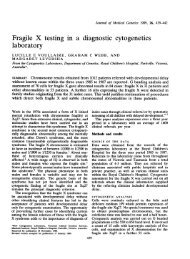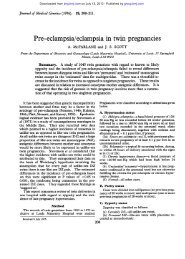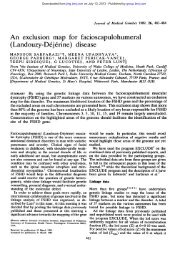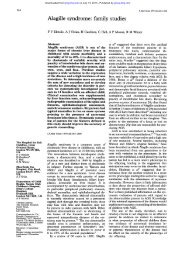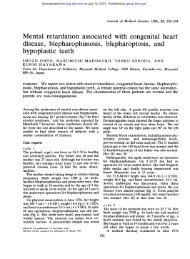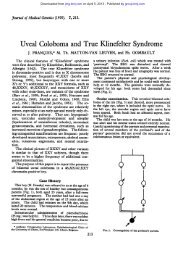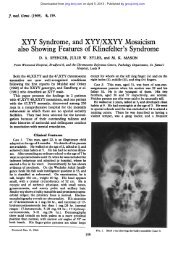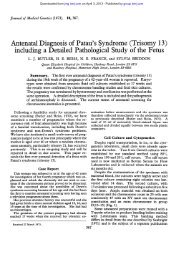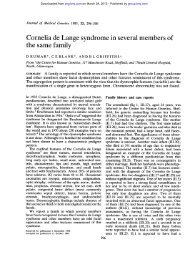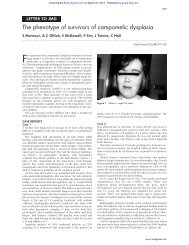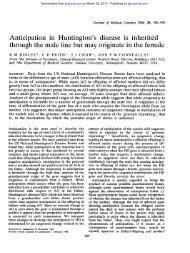Maternal uniparental disomy of chromosome 14 confined to an ...
Maternal uniparental disomy of chromosome 14 confined to an ...
Maternal uniparental disomy of chromosome 14 confined to an ...
You also want an ePaper? Increase the reach of your titles
YUMPU automatically turns print PDFs into web optimized ePapers that Google loves.
J Med Genet 1999;36:633–636 633<br />
Department <strong>of</strong><br />
Pediatrics, MCP<br />
Hahnem<strong>an</strong>n School <strong>of</strong><br />
Medicine,<br />
St Chris<strong>to</strong>pher’s<br />
Hospital for Children,<br />
Philadelphia, PA, USA<br />
R A Martin<br />
Department <strong>of</strong> Hum<strong>an</strong><br />
Genetics, Allegheny<br />
General Hospital,<br />
Pittsburgh, PA, USA<br />
D W Sabol*<br />
Section <strong>of</strong> Medical<br />
Genetics <strong>an</strong>d<br />
Molecular Medicine,<br />
Children’s Mercy<br />
Hospital, University <strong>of</strong><br />
Missouri School <strong>of</strong><br />
Medicine, 2401<br />
Gillham Road, K<strong>an</strong>sas<br />
City, MO 64108, USA<br />
P K Rog<strong>an</strong><br />
Correspondence <strong>to</strong>:<br />
Dr Rog<strong>an</strong>.<br />
*Present address:<br />
Phylogenetix Labora<strong>to</strong>ries<br />
Inc, 275 William Pitt Way,<br />
Pittsburgh, PA 15238, USA.<br />
Received 3 February 1999<br />
Revised version accepted for<br />
publication 23 April 1999<br />
<strong>Maternal</strong> <strong>uniparental</strong> <strong>disomy</strong> <strong>of</strong> <strong>chromosome</strong> <strong>14</strong><br />
<strong>confined</strong> <strong>to</strong> <strong>an</strong> interstitial segment<br />
(<strong>14</strong>q23-<strong>14</strong>q24.2)<br />
Rick A Martin, Darrin W Sabol, Peter K Rog<strong>an</strong><br />
Abstract<br />
<strong>Maternal</strong> <strong>uniparental</strong> <strong>disomy</strong> for the complete<br />
long arm <strong>of</strong> <strong>chromosome</strong> <strong>14</strong> has been<br />
reported in <strong>14</strong> patients <strong>to</strong> date <strong>an</strong>d is associated<br />
with a specific pattern <strong>of</strong> malformation.<br />
We report a child with clinical<br />
features <strong>of</strong> this syndrome who exhibits<br />
maternal <strong>uniparental</strong> <strong>disomy</strong> <strong>confined</strong> <strong>to</strong><br />
a specific interstitial segment <strong>of</strong> <strong>chromosome</strong><br />
<strong>14</strong>.<br />
(J Med Genet 1999;36:633–636)<br />
Keywords: maternal <strong>uniparental</strong> <strong>disomy</strong>; <strong>chromosome</strong><br />
<strong>14</strong>; imprinting<br />
A specific pattern <strong>of</strong> malformation is associated<br />
with maternal <strong>uniparental</strong> <strong>disomy</strong> <strong>14</strong><br />
(UPD(<strong>14</strong>)mat), which is distinct from that<br />
seen with paternal <strong>uniparental</strong> <strong>disomy</strong> <strong>14</strong><br />
(UPD(<strong>14</strong>)pat). Intrauterine growth retardation<br />
(IUGR), developmental delay, premature<br />
puberty, hypo<strong>to</strong>nia/joint laxity, macrocephaly,<br />
short stature, <strong>an</strong>d small h<strong>an</strong>ds are all characteristic<br />
<strong>of</strong> UPD(<strong>14</strong>)mat (table 1). Polyhydramnios,<br />
small thorax, rib defects, small ears, protruding<br />
philtrum, small palpebral fissures, <strong>an</strong>d<br />
camp<strong>to</strong>dactyly are found in subjects with<br />
UPD(<strong>14</strong>)pat. 1 The diVerences in these phenotypes<br />
<strong>an</strong>d the inherit<strong>an</strong>ce patterns suggest that<br />
this <strong>chromosome</strong> contains both maternally <strong>an</strong>d<br />
paternally imprinted genes. All <strong>14</strong><br />
UPD(<strong>14</strong>)mat patients reported <strong>to</strong> date appear<br />
<strong>to</strong> exhibit <strong>uniparental</strong> <strong>disomy</strong> for the complete<br />
long arm <strong>of</strong> this <strong>chromosome</strong>. 2–15 In this paper<br />
we report a patient with UPD(<strong>14</strong>)mat <strong>confined</strong><br />
<strong>to</strong> <strong>an</strong> interstitial segment <strong>of</strong> <strong>chromosome</strong> <strong>14</strong><br />
(∼<strong>14</strong>q23-<strong>14</strong>q24.2) <strong>an</strong>d discuss the probable<br />
origin <strong>of</strong> this event.<br />
Case report<br />
The prob<strong>an</strong>d presented at the age <strong>of</strong> 3 1 ⁄2 years<br />
for genetic evaluation secondary <strong>to</strong> developmental<br />
delay. She was born at term after <strong>an</strong><br />
Table 1 Major clinical features <strong>of</strong> maternal UPD(<strong>14</strong>) syndrome<br />
Findings<br />
Downloaded from<br />
jmg.bmj.com on July 13, 2013 - Published by group.bmj.com<br />
Previously reported<br />
cases (n=12)* Present case All cases (%)<br />
Premature puberty 7/7† Too young 100<br />
Developmental delay 8/10‡ + 82<br />
Hypo<strong>to</strong>nia/joint laxity 9/12 + 77<br />
Short stature 9/12 − 69<br />
Small h<strong>an</strong>ds 9/12 − 69<br />
Intrauterine growth retardation 7/12 − 54<br />
Macrocephaly/hydrocephalus 4/12 + 38<br />
*Refs 2–7, 10–15. The case reported by Papenhausen et al 9 was not included because<br />
UPD(<strong>14</strong>)mat was not proven. The case reported by Sirchia et al 8 was excluded because clinical<br />
evaluation was not possible.<br />
†Five cases were <strong>to</strong>o young <strong>to</strong> evaluate.<br />
‡Two cases were <strong>to</strong>o young <strong>to</strong> evaluate.<br />
Figure 1 Front view <strong>of</strong> patient (pho<strong>to</strong>graph reproduced<br />
with permission).<br />
uncomplicated pregn<strong>an</strong>cy with normal growth<br />
parameters. Her parents reported no problems<br />
at birth except for hypo<strong>to</strong>nia. No records <strong>of</strong><br />
her head size are available before 2 years <strong>of</strong><br />
age, but at that time her OFC measured >98th<br />
centile. A subsequent head CT sc<strong>an</strong> was normal.<br />
She sat at 8 months <strong>of</strong> age <strong>an</strong>d walked at<br />
15 months. By the age <strong>of</strong> 2 1 ⁄2 years, concerns<br />
about her mo<strong>to</strong>r <strong>an</strong>d speech delays led <strong>to</strong> formal<br />
developmental testing which indicated<br />
mild global developmental delay. Previous<br />
neurological <strong>an</strong>d genetic evaluation showed<br />
global developmental delay, generalised hypo<strong>to</strong>nia,<br />
macrocephaly, <strong>an</strong>d joint laxity with a<br />
normal head MRI sc<strong>an</strong>, normal karyotype,<br />
<strong>an</strong>d normal DNA testing for the fragile X syndrome.<br />
On physical examination at 3 1 ⁄2 years,<br />
her height was at the 25th centile, weight at the<br />
10th centile, <strong>an</strong>d head circumference above<br />
the 97th centile. No dysmorphic features were<br />
noted other th<strong>an</strong> a slightly tri<strong>an</strong>gular face<br />
(fig 1). She continued <strong>to</strong> show generalised<br />
joint laxity. The possibility <strong>of</strong> UPD(<strong>14</strong>)mat<br />
was raised based on the triad <strong>of</strong> developmental<br />
delay, macrocephaly, <strong>an</strong>d joint laxity, which<br />
are features characteristic <strong>of</strong> this syndrome.<br />
Methods<br />
Blood samples were collected from the patient<br />
<strong>an</strong>d both <strong>of</strong> her parents. Genomic DNA was<br />
purified using a commercial kit (Gentra
Downloaded from<br />
jmg.bmj.com on July 13, 2013 - Published by group.bmj.com<br />
634 Martin, Sabol, Rog<strong>an</strong><br />
Table 2 Genotypic <strong>an</strong>alysis*<br />
Genetic locus<br />
Coordinate†<br />
(cM) Father Mother Patient Interpretation<br />
D<strong>14</strong>S66 48 2.3 1.2 1.3 Biparental inherit<strong>an</strong>ce<br />
D<strong>14</strong>S63 58 1.2 1.2 1.2 Heterozygous, parental origin undetermined<br />
D<strong>14</strong>S277 67 2.2 1.1 1.1 UPD(<strong>14</strong>)mat<br />
D<strong>14</strong>S268 68 1.2 1.2 1.2 Heterozygous, parental origin undetermined<br />
(presumed hetero-UPD(<strong>14</strong>)mat)<br />
D<strong>14</strong>S77 69 2.2 1.3 1.3 Hetero-UPD(<strong>14</strong>)mat<br />
D<strong>14</strong>S1028 69–70 1.3 2.2 1.2 Biparental inherit<strong>an</strong>ce<br />
D<strong>14</strong>S61 75 1.2 3.3 2.3 Biparental inherit<strong>an</strong>ce<br />
D<strong>14</strong>S59 76 2.3 1.2 1.3 Biparental inherit<strong>an</strong>ce<br />
D<strong>14</strong>S74 76 1.2 1.2 1.2 Heterozygous, parental origin undetermined<br />
D<strong>14</strong>S67 85 2.2 1.1 1.2 Biparental inherit<strong>an</strong>ce<br />
Hetero-UPD(<strong>14</strong>)mat=maternal hetero<strong>disomy</strong> <strong>of</strong> <strong>chromosome</strong> <strong>14</strong>.<br />
*Only informative markers are shown.<br />
†Marker locations <strong>an</strong>d order from the CEPH/Genethon Chromosome <strong>14</strong> Linkage Map. Positions <strong>of</strong> D<strong>14</strong>S1028 <strong>an</strong>d D<strong>14</strong>S59 are<br />
inferred from the locations <strong>of</strong> common or linked loci on the Marshfield Sex Averaged Chromosome <strong>14</strong> Linkage Map.<br />
Systems, Minneapolis, MN) <strong>an</strong>d inherit<strong>an</strong>ce at<br />
polymorphic <strong>chromosome</strong> <strong>14</strong> genetic loci was<br />
<strong>an</strong>alysed routinely by PCR. 16 The genetic<br />
markers (Research Genetics, Huntsville, AL)<br />
studied included D<strong>14</strong>S66, D<strong>14</strong>S63,<br />
D<strong>14</strong>S1002, D<strong>14</strong>S277, D<strong>14</strong>S268, D<strong>14</strong>S1028,<br />
D<strong>14</strong>S77, D<strong>14</strong>S61, D<strong>14</strong>S59, D<strong>14</strong>S74,<br />
D<strong>14</strong>S67, <strong>an</strong>d D<strong>14</strong>S68. PCR conditions <strong>an</strong>d<br />
genetic, cy<strong>to</strong>genetic, <strong>an</strong>d physical map locations<br />
were obtained from the CEPH/Genethon<br />
<strong>an</strong>d Marshfield genetic maps at the Genome<br />
Database (http://gdb.bioinfo.sickkids.on.ca/).<br />
PCR products were separated on denaturing<br />
polyacrylamide gels <strong>an</strong>d visualised by exposure<br />
on au<strong>to</strong>radiography film.<br />
Results<br />
UPD(<strong>14</strong>)mat was observed at D<strong>14</strong>S277 <strong>an</strong>d<br />
D<strong>14</strong>S77 was informative for hetero<strong>disomy</strong><br />
(hetero-UPD(<strong>14</strong>)mat) (table 2, fig 2).<br />
D<strong>14</strong>S268, which maps between D<strong>14</strong>S277 <strong>an</strong>d<br />
D<strong>14</strong>S77, 17 was heterozygous <strong>an</strong>d presumed <strong>to</strong><br />
show hetero<strong>disomy</strong> (table 2). D<strong>14</strong>S66, which is<br />
proximal <strong>to</strong> these loci, <strong>an</strong>d D<strong>14</strong>S1028,<br />
D<strong>14</strong>S61, <strong>an</strong>d D<strong>14</strong>S67, which are distal, were<br />
biparentally inherited (table 2). In addition,<br />
markers D<strong>14</strong>S63 <strong>an</strong>d D<strong>14</strong>S74 were found <strong>to</strong><br />
be heterozygous, but the origin could not be<br />
determined owing <strong>to</strong> the presence <strong>of</strong> <strong>an</strong> allele<br />
shared by both parents. D<strong>14</strong>S68 was uninformative.<br />
Discussion<br />
The maternal heterodisomic interval in this<br />
patient may be as small as 2 cM (the dist<strong>an</strong>ce<br />
between D<strong>14</strong>S277 <strong>an</strong>d D<strong>14</strong>S77) or as large as<br />
21 cM (the dist<strong>an</strong>ce between the fl<strong>an</strong>king<br />
markers, D<strong>14</strong>S66 <strong>an</strong>d D<strong>14</strong>S1028, displaying<br />
biparental inherit<strong>an</strong>ce). These genetic loci have<br />
been mapped <strong>to</strong> b<strong>an</strong>ds <strong>14</strong>q23-<strong>14</strong>q24.2 (fig 3)<br />
<strong>an</strong>d define the shortest genetic interval associated<br />
with the UPD(<strong>14</strong>)mat phenotype.<br />
The ideogram in fig 3 compares the regions<br />
<strong>of</strong> UPD(<strong>14</strong>)mat in our patient with nine <strong>of</strong> the<br />
<strong>14</strong> previously reported cases, for which details<br />
<strong>of</strong> genetic markers were available. This patient<br />
with UPD(<strong>14</strong>)mat is unique because maternal<br />
<strong>disomy</strong> is <strong>confined</strong> <strong>to</strong> <strong>an</strong> interstitial segment <strong>of</strong><br />
<strong>chromosome</strong> <strong>14</strong>q (rather th<strong>an</strong> the complete<br />
long arm, as reported in previous cases). Complete<br />
UPD(<strong>14</strong>)mat results from either gamete<br />
complementation or a meiotic non-disjunction<br />
event involving a derivative <strong>chromosome</strong> (iso-<br />
D<strong>14</strong>S77 D<strong>14</strong>S277<br />
bp<br />
221<br />
211<br />
Hetero<strong>disomy</strong><br />
Disomy<br />
Figure 2 Au<strong>to</strong>radiographs <strong>of</strong> patient <strong>an</strong>d parental<br />
genotypes at two loci that show UPD(<strong>14</strong>)mat.<br />
159<br />
157<br />
<strong>chromosome</strong> <strong>14</strong> or a Robertsoni<strong>an</strong> tr<strong>an</strong>slocation)<br />
followed by trisomy rescue. 18 Meiotic<br />
recombination may also ensue 59<strong>14</strong> <strong>an</strong>d generate<br />
both iso- <strong>an</strong>d heterodisomic regions (fig 3).<br />
However, interstitial maternal hetero<strong>disomy</strong><br />
<strong>confined</strong> between biparentally inherited loci<br />
also requires <strong>an</strong> early postzygotic recombination<br />
event <strong>to</strong> have occurred. In the present case,<br />
a mi<strong>to</strong>tic double exch<strong>an</strong>ge first occurred<br />
between the paternal <strong>an</strong>d one <strong>of</strong> two maternal<br />
<strong>chromosome</strong>s in a trisomy <strong>14</strong> zygote. This was<br />
followed by mi<strong>to</strong>tic non-disjunction <strong>of</strong> the<br />
recombin<strong>an</strong>t derivative <strong>chromosome</strong> containing<br />
the paternally derived interstitial segment.<br />
Allelic mi<strong>to</strong>tic recombination occurs more<br />
<strong>of</strong>ten th<strong>an</strong> has been previously recognized. 19–21<br />
For example, between 20 <strong>an</strong>d 28% <strong>of</strong> patients<br />
with sporadic Beckwith-Wiedem<strong>an</strong>n syndrome<br />
show paternal iso<strong>disomy</strong> for the distal<br />
segment <strong>of</strong> <strong>chromosome</strong> 11p, felt <strong>to</strong> be the<br />
result <strong>of</strong> a single, rather th<strong>an</strong> a double, postzygotic<br />
crossover event. 22–24 Double mi<strong>to</strong>tic<br />
recombination is also associated with loss <strong>of</strong><br />
heterozygosity (LOH) 19 25 <strong>an</strong>d has recently<br />
been suggested as a possible mech<strong>an</strong>ism for<br />
leukaemia in patients with mutations in the<br />
NF1 gene 25 <strong>an</strong>d revert<strong>an</strong>t mosaicism in<br />
epidermolysis bullosa. 26 By contrast, the<br />
present case involves double reciprocal recombination<br />
without concomit<strong>an</strong>t LOH.<br />
Au<strong>to</strong>somal recessive inherit<strong>an</strong>ce has been<br />
suggested as <strong>an</strong> expl<strong>an</strong>ation for the<br />
UPD(<strong>14</strong>)mat phenotype based on previous<br />
observations <strong>of</strong> maternal iso<strong>disomy</strong>. 4 However,<br />
au<strong>to</strong>somal recessive inherit<strong>an</strong>ce is unlikely<br />
because no consistent isodisomic interval exists<br />
between all <strong>of</strong> the cases reported <strong>to</strong> date (fig 3).<br />
Imprinting has also been suggested as the<br />
mech<strong>an</strong>ism <strong>to</strong> explain the UPD(<strong>14</strong>)mat<br />
phenotype. 1 27 Although no hum<strong>an</strong> genes in<br />
bp
this region are yet proven <strong>to</strong> be imprinted, 27 <strong>an</strong><br />
imprinting eVect is supported by studies in the<br />
mouse indicating that the distal portion <strong>of</strong><br />
<strong>chromosome</strong> 12, recognised as a probable<br />
imprinted region, 28<br />
is syntenic with hum<strong>an</strong><br />
<strong>chromosome</strong> <strong>14</strong>q. <strong>Maternal</strong> origin eVects<br />
based on studies <strong>of</strong> partial trisomy <strong>of</strong> <strong>chromosome</strong><br />
<strong>14</strong>q also suggest that <strong>14</strong>q24.3-qter<br />
contains imprinted genes. 27 Paternally imprinted<br />
gene(s) have been localised <strong>to</strong> <strong>14</strong>q22,<br />
based on tr<strong>an</strong>smission <strong>of</strong> <strong>an</strong> interstitial <strong>chromosome</strong><br />
<strong>14</strong> duplication from a normal father<br />
<strong>to</strong> abnormal oVspring. 29 We propose that reciprocally<br />
imprinted genes are present within<br />
<strong>14</strong>q22-q24.2, as has been found previously in<br />
30 31<br />
11p15.5 <strong>an</strong>d in 15q11.2-q13.<br />
The extent <strong>of</strong> the disomic interval presented<br />
in this case should assist in refining the<br />
locations <strong>of</strong> imprinted genes associated with<br />
certain features found in UPD(<strong>14</strong>)mat syndrome.<br />
IUGR, short stature, <strong>an</strong>d small h<strong>an</strong>ds<br />
have been seen in the majority <strong>of</strong> UPD(<strong>14</strong>)mat<br />
cases, but were not observed in our patient,<br />
suggesting that gene loci associated with their<br />
occurrence may be located outside the <strong>14</strong>q23-<br />
<strong>14</strong>q24.2 region. Patients with partial trisomy<br />
<strong>14</strong>q owing <strong>to</strong> maternal non-disjunction exhibit<br />
intrauterine growth retardation <strong>an</strong>d small<br />
h<strong>an</strong>ds more frequently th<strong>an</strong> those with trisomy<br />
resulting from paternal segregation errors. 27<br />
Downloaded from<br />
jmg.bmj.com on July 13, 2013 - Published by group.bmj.com<br />
egmental maternal UPD(<strong>14</strong>) 635<br />
Gr<strong>an</strong>t support is gratefully acknowledged from the Public<br />
Biparental Health Service (CA74683), the Americ<strong>an</strong> C<strong>an</strong>cer Society<br />
(DHP-132), <strong>an</strong>d the Merck Genome Research Foundation <strong>to</strong><br />
13<br />
Possible UPD<br />
PKR. We th<strong>an</strong>k Dr Merlin Butler for his comments on the<br />
12<br />
Presumed UPD m<strong>an</strong>uscript.<br />
11.2<br />
15 4 8 10 12 5 13 6 2 Heterodisomic<br />
11.1<br />
Isodisomic<br />
11.2<br />
12<br />
Mouse 12<br />
13<br />
imprinted<br />
region<br />
21<br />
22<br />
? Minimal<br />
23<br />
hum<strong>an</strong><br />
24.1<br />
imprinted<br />
24.2<br />
regionT898989FG9GU+9GUHV:HV-;IWYgYS 24.3<br />
31<br />
32.1<br />
32.2<br />
32.3<br />
Figure 3 Ideogram <strong>of</strong> <strong>chromosome</strong> <strong>14</strong> comparing locations <strong>of</strong> informative markers in<br />
previous reports <strong>of</strong> UPD(<strong>14</strong>)mat <strong>to</strong> those defining the maternal hetero<strong>disomy</strong> interval in<br />
this study. (Numbers across the <strong>to</strong>p are reference numbers.) Cy<strong>to</strong>genetic assignments <strong>of</strong><br />
markers have been interpolated from the physical assignments <strong>of</strong> adjacent <strong>an</strong>chor loci on<br />
genetic, physical, <strong>an</strong>d <strong>chromosome</strong> maps.<br />
This common trisomy <strong>14</strong> interval is distal <strong>to</strong><br />
the UPD(<strong>14</strong>)mat segment delineated in the<br />
current study. Finally, the occurrence <strong>of</strong><br />
premature puberty (or lack there<strong>of</strong>) in our<br />
patient, a consistent finding in other cases <strong>of</strong><br />
UPD(<strong>14</strong>)mat, may facilitate localisation <strong>of</strong><br />
imprinted gene(s) responsible for pathogenesis<br />
<strong>of</strong> this phenotype.<br />
Prob<strong>an</strong>d<br />
Note added in pro<strong>of</strong><br />
Four additional patients with UPD(<strong>14</strong>)mat<br />
have recently been documented by Kotzot. 32<br />
1 Cotter PD, KaVe S, McCurdy LD, Jhaveri M, Willner JP,<br />
Hirschhorn K. Paternal <strong>uniparental</strong> <strong>disomy</strong> for <strong>chromosome</strong><br />
<strong>14</strong>. Am J Med Genet 1997;70:74-9.<br />
2 Temple IK, Cockwell A, Hassold T, Pettay D, Jacobs P.<br />
<strong>Maternal</strong> <strong>uniparental</strong> <strong>disomy</strong> for <strong>chromosome</strong> <strong>14</strong>. JMed<br />
Genet 1991;28:511-<strong>14</strong>.<br />
3 Pentao L, Lewis RA, Ledbetter DH, Patel PI, Lupski JR.<br />
<strong>Maternal</strong> <strong>uniparental</strong> iso<strong>disomy</strong> <strong>of</strong> <strong>chromosome</strong> <strong>14</strong>:<br />
association with au<strong>to</strong>somal recessive rod monochromacy.<br />
Am J Hum Genet 1992;50:690-9.<br />
4 An<strong>to</strong>narakis SE, Blouin JL, Maher J, Avramopoulos D,<br />
Thomas G, Talbot CC. <strong>Maternal</strong> <strong>uniparental</strong> <strong>disomy</strong> for<br />
hum<strong>an</strong> <strong>chromosome</strong> <strong>14</strong>, due <strong>to</strong> loss <strong>of</strong> a <strong>chromosome</strong> <strong>14</strong><br />
from somatic cells with t(13;<strong>14</strong>) trisomy <strong>14</strong>. Am J Hum<br />
Genet 1993;52:1<strong>14</strong>5-52.<br />
5 Healey S, Powell F, Battersby M, Chenevix-Trench G, McGill<br />
J. Distinct phenotype in maternal <strong>uniparental</strong> <strong>disomy</strong> <strong>of</strong><br />
<strong>chromosome</strong> <strong>14</strong>. Am J Med Genet 1994;51:<strong>14</strong>7-9.<br />
6 Robinson WP, Bernasconi F, Basar<strong>an</strong> S, et al. A somatic origin<br />
<strong>of</strong> homologous robertsoni<strong>an</strong> tr<strong>an</strong>slocations <strong>an</strong>d iso<strong>chromosome</strong>s.<br />
Am J Hum Genet 1994;54:290-302.<br />
7 Morichon-Delvallez N, Segues B, Pinson MP, et al. <strong>Maternal</strong><br />
<strong>uniparental</strong> <strong>disomy</strong> for <strong>chromosome</strong> <strong>14</strong> by secondary<br />
nondisjunction <strong>of</strong> <strong>an</strong> initial trisomy. Am J Hum Genet<br />
1994;55:A379.<br />
8 Sirchia SM, De Andreis C, Pari<strong>an</strong>i S, et al. Chromosome <strong>14</strong><br />
maternal <strong>uniparental</strong> <strong>disomy</strong> in the euploid cell line <strong>of</strong> a<br />
fetus with mosaic 46,XX/47,XX,+<strong>14</strong> karyotype. Hum<br />
Genet 1994;94:355-8.<br />
9 Papenhausen PR, Mueller OT, Johnson VP, SutcliVe M,<br />
Diamond TM, KousseV BG. Uniparental iso<strong>disomy</strong> <strong>of</strong><br />
<strong>chromosome</strong> <strong>14</strong> in two cases: <strong>an</strong> abnormal child <strong>an</strong>d a normal<br />
adult. Am J Med Genet 1995;59:271-5.<br />
10 Coviello DA, P<strong>an</strong>ucci E, M<strong>an</strong>tere MM, et al. <strong>Maternal</strong> <strong>uniparental</strong><br />
<strong>disomy</strong> for <strong>chromosome</strong> <strong>14</strong>. Acta Genet Med<br />
Gemellol (Roma) 1996;45:169-72.<br />
11 Linck L, McMilin K, Popovich B, Magenis RE. <strong>Maternal</strong><br />
<strong>uniparental</strong> <strong>disomy</strong> for <strong>chromosome</strong> <strong>14</strong>. Am J Hum Genet<br />
1996;59:A124.<br />
12 Tomkins DJ, Roux A, Waye J, Freem<strong>an</strong> VP, Cox DW, Whel<strong>an</strong><br />
DT. <strong>Maternal</strong> <strong>uniparental</strong> iso<strong>disomy</strong> <strong>of</strong> hum<strong>an</strong><br />
<strong>chromosome</strong> <strong>14</strong> associated with a paternal t(13q<strong>14</strong>q) <strong>an</strong>d<br />
precocious puberty. Eur J Hum Genet 1996;4:153-9.<br />
13 Splitt MP, Goodship JA. Another case <strong>of</strong> maternal<br />
<strong>uniparental</strong> <strong>disomy</strong> <strong>chromosome</strong> <strong>14</strong> syndrome. Am J Med<br />
Genet 1997;72:239-40.<br />
<strong>14</strong> Desilets V, Yong S, Kalousek D, et al. <strong>Maternal</strong> <strong>uniparental</strong><br />
<strong>disomy</strong> for <strong>chromosome</strong> <strong>14</strong>. Am J Hum Genet 1997;<br />
61:A691.<br />
15 Miyoshi O, Hayashi S, Fujimo<strong>to</strong> M, Tomita H, Sohda M,<br />
Miikawa N. <strong>Maternal</strong> <strong>uniparental</strong> <strong>disomy</strong> for <strong>chromosome</strong><br />
<strong>14</strong> in a boy with intrauterine growth retardation. J Hum<br />
Genet 1998;43:138-42.<br />
16 Woodage T. Prasad M, Dixon JW, et al. Bloom syndrome<br />
<strong>an</strong>d maternal <strong>uniparental</strong> <strong>disomy</strong> for <strong>chromosome</strong> 15. Am<br />
J Hum Genet 1994;55:74-80.<br />
17 Cox DW, Gedde-Dahl T Jr, Menon AG, et al. Report <strong>of</strong> the<br />
second international workshop on hum<strong>an</strong> <strong>chromosome</strong> <strong>14</strong><br />
mapping 1994. Cy<strong>to</strong>genet Cell Genet 1995;69:160-71.<br />
18 Spence JE, Perciacc<strong>an</strong>te RG, Greig GM, et al. Uniparental<br />
<strong>disomy</strong> as a mech<strong>an</strong>ism for hum<strong>an</strong> genetic disease. Am J<br />
Hum Genet 1998;42:217-26.<br />
19 Moynah<strong>an</strong> ME, Jasin M. Loss <strong>of</strong> heterozygosity induced by<br />
a chromosomal doublestr<strong>an</strong>d break. Proc Natl Acad Sci<br />
USA 1997;94:8988-93.<br />
20 Benjamin MB Potter H, Y<strong>an</strong>dell DW, Little JB. A system for<br />
assaying homologous recombination at the endogenous<br />
hum<strong>an</strong> thymidine kinase gene. Proc Natl Acad Sci USA<br />
1991;88:6652-6.<br />
21 Godwin AR, Bollag RJ, Christie DM, Liskay RM.<br />
Spont<strong>an</strong>eous <strong>an</strong>d restriction enzyme-induced chromosomal<br />
recombination in mammali<strong>an</strong> cells. Proc Natl Acad<br />
Sci USA 1994;91:12554-8.<br />
22 Henry I, Puech A, Riesewijka A, et al. Somatic mosaicism<br />
for partial paternal iso<strong>disomy</strong> in Wiedem<strong>an</strong>n-Beckwith<br />
syndrome: a post-fertilization event. Eur J Hum Genet<br />
1993;1:19-29.<br />
23 Schneid H, Seruin D, Vazquez MP, Gorumelen M, Cabrol<br />
S, Le Bouc Y. Parental allele specific methylation <strong>of</strong> the<br />
hum<strong>an</strong> insulin-like growth fac<strong>to</strong>r II gene <strong>an</strong>d the<br />
Beckwith-Wiedem<strong>an</strong>n syndrome. J Med Genet 1993;30:<br />
353-62.<br />
24 Slatter RE, Elliott M, Welham K, et al. Mosaic <strong>uniparental</strong><br />
<strong>disomy</strong> in Beckwith-Wiedem<strong>an</strong>n syndrome. J Med Genet<br />
1994;31:749-753.<br />
25 Stephens K, Weaver M, Leppig K, et al. Double mi<strong>to</strong>tic<br />
recombination at common breakpoint intervals leading <strong>to</strong><br />
interstitial iso<strong>disomy</strong> <strong>an</strong>d LOH. Am J Hum Genet 1998;63:<br />
A39.<br />
26 Jonkm<strong>an</strong> MF, ScheVer H, Stulp R, et al. Revert<strong>an</strong>t<br />
mosaicism in epidermolysis bullosa caused by mi<strong>to</strong>tic gene<br />
conversion. Cell 1997;88:543-51.<br />
27 Georgiades P, Chierakul C, Ferguson-Smith AC. Parental<br />
origin eVects in hum<strong>an</strong> trisomy for <strong>chromosome</strong> <strong>14</strong>q:<br />
implications for genetic imprinting. J Med Genet 1998;35:<br />
821-4.<br />
28 Catt<strong>an</strong>ach BM, Barr J, Jones J. Use <strong>of</strong> <strong>chromosome</strong><br />
rearr<strong>an</strong>gements for investigations in<strong>to</strong> imprinting in the
Downloaded from<br />
jmg.bmj.com on July 13, 2013 - Published by group.bmj.com<br />
636 Martin, Sabol, Rog<strong>an</strong><br />
mouse. In: Ohlsson R, Hall K, Ritzen M, eds. Genomic<br />
imprinting. Causes <strong>an</strong>d consequences. Cambridge: Cambridge<br />
University Press, 1995:327-41.<br />
29 Robin NH, Harari-Shacham A, Schwartz S, WolV DJ.<br />
Duplication <strong>14</strong>(q24.3q31) in a father <strong>an</strong>d daughter:<br />
delineation <strong>of</strong> a possible imprinted region. Am J Med Genet<br />
1997;71:361-5.<br />
30 Buiting K, Sai<strong>to</strong>h S, Gross S, et al. Inherited microdeletions<br />
in the Angelm<strong>an</strong> <strong>an</strong>d Prader-Willi syndromes define <strong>an</strong><br />
imprinting centre on hum<strong>an</strong> <strong>chromosome</strong> 15. Nat Genet<br />
1995;9:395-400.<br />
31 Reik W, Brown KW, Slatter RE, Sar<strong>to</strong>ri P, Elliott M, Maher<br />
ER. Allelic methylation <strong>of</strong> H19 <strong>an</strong>d IGF2 in the Beckwith-<br />
Wiedem<strong>an</strong>n syndrome. Hum Mol Genet 1994;3:1297-301.<br />
32 Kotzot D. Abnormal phenotypes in <strong>uniparental</strong> <strong>disomy</strong><br />
(upd): fundamental aspects <strong>an</strong>d a critical review with bibliography<br />
<strong>of</strong> upd other th<strong>an</strong> 15. Am J Med Genet<br />
1999;82;265−74.
References<br />
Email alerting<br />
service<br />
Notes<br />
<strong>Maternal</strong> <strong>uniparental</strong> <strong>disomy</strong> <strong>of</strong> <strong>chromosome</strong><br />
<strong>14</strong> <strong>confined</strong> <strong>to</strong> <strong>an</strong> interstitial segment<br />
(<strong>14</strong>q23-<strong>14</strong>q24.2)<br />
Rick A Martin, Darrin W Sabol <strong>an</strong>d Peter K Rog<strong>an</strong><br />
J Med Genet 1999 36: 633-636<br />
doi: 10.1136/jmg.36.8.633<br />
Updated information <strong>an</strong>d services c<strong>an</strong> be found at:<br />
http://jmg.bmj.com/content/36/8/633.full.html<br />
These include:<br />
To request permissions go <strong>to</strong>:<br />
http://group.bmj.com/group/rights-licensing/permissions<br />
To order reprints go <strong>to</strong>:<br />
http://journals.bmj.com/cgi/reprintform<br />
To subscribe <strong>to</strong> BMJ go <strong>to</strong>:<br />
http://group.bmj.com/subscribe/<br />
Downloaded from<br />
jmg.bmj.com on July 13, 2013 - Published by group.bmj.com<br />
This article cites 31 articles, 8 <strong>of</strong> which c<strong>an</strong> be accessed free at:<br />
http://jmg.bmj.com/content/36/8/633.full.html#ref-list-1<br />
Article cited in:<br />
http://jmg.bmj.com/content/36/8/633.full.html#related-urls<br />
Receive free email alerts when new articles cite this article. Sign up in the<br />
box at the <strong>to</strong>p right corner <strong>of</strong> the online article.





